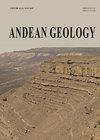Unexpected coseismic surface uplift at Tirúa-Mocha Island area of south Chile before and during the Mw 8.8 Maule 2010 earthquake: a possible upper plate splay fault
IF 1.2
4区 地球科学
Q3 GEOLOGY
引用次数: 4
Abstract
The Tirúa-Mocha Island area (38.2°-38.4° S) in southern Chile has been affected by two megaearthquakes in only 50 years: the 1960 Mw=9.5 Valdivia earthquake and 2010 Mw=8.8 Maule earthquake. We studied in the field the vertical ground movements occurred during the interseismic period between both earthquakes and the coseismic period of 2010 Maule earthquake and 2011 Mw=7.1 Araucanía earthquake. During the 1960 earthquake, vertical coseismic ground movements are typical of subduction related earthquakes with Mocha Island, located close to the trench, experienced bigger ground uplift (150 cm) than that occurred in Tirúa (-20 cm), place located in the continental margin at the latitude of Mocha Island. Then during the 1960-2010 interseismic period, the 1960 coseismic uplift remained at Mocha Island unlike the normal interseismic subsidence that occurred northward at Arauco Peninsula and Santa María Island. Also Tirúa experienced the biggest interseismic uplift (180 cm) in all the area affected later by 2010 Maule earthquake. Then during the 2010 Mw=8.8 Maule earthquake an anomalous vertical coseismic ground uplift occurred in the study area, opposite to that of 1960 since Mocha Island experienced lower (25 cm) ground uplift than Tirúa (90 cm). Subsequently, during the Araucanía 2011 earthquake a ground uplift in Mocha Island (50 cm) and subsidence at Tirúa (20 cm) occurred. These unexpected vertical ground movements can be explained by the existence of an upper plate splay fault located below the sea bottom between Tirúa and Mocha Island: the Tirúa-Mocha splay fault. Considering the last seismic cycle, the activity of this fault would have started after the 1960 Valdivia earthquake. During 2010 Maule earthquake, the main slip occurred at Tirúa Mocha splay fault. Finally during 2011 Araucanía earthquake, the slip occurred mainly at the updip of Wadati-Benioff plane with probable normal activity of Tirúa-Mocha splay fault. Simple elastic dislocation models considering the Wadati-Benioff plane and the Tirúa-Mocha splay fault activity, can account for all the vertical ground movements observed during 1960 earthquake, the 1960-2010 interseismic period, the 2010 Maule earthquake and the 2011 Araucanía earthquake.2010年毛勒8.8级地震前后,智利南部蒂鲁阿莫查岛地区意外的同震地表隆起:可能的上盘扇断层
智利南部的蒂鲁阿-莫查岛地区(38.2°-38.4°S)在短短50年内遭受了两次大地震的影响:1960年瓦尔迪维亚9.5级地震和2010年毛勒8.8级地震。我们在野外研究了两次地震之间的震间期以及2010年Maule地震和2011年Mw=7.1 Araucanía地震的同震期发生的垂直地面运动。在1960年的地震中,垂直同震地面运动是典型的俯冲相关地震,位于海沟附近的莫查岛经历了比位于莫查岛纬度大陆边缘的蒂鲁阿(-20厘米)更大的地面隆起(150厘米)。然后,在1960-2010年的震间期,1960年的同震隆升仍在莫查岛,这与阿劳科半岛和圣玛丽亚岛向北发生的正常震间沉降不同。此外,蒂鲁阿在受2010年毛勒地震影响的所有地区都经历了最大的震间隆起(180厘米)。然后,在2010年Mw=8.8 Maule地震期间,研究区域发生了异常的垂直同震地面隆起,与1960年相反,因为Mocha岛的地面隆起(25厘米)低于Tirúa(90厘米)。随后,在2011年阿劳卡尼亚地震期间,莫查岛发生了地面隆起(50厘米),蒂鲁阿发生了地面沉降(20厘米)。这些意想不到的垂直地面运动可以通过位于蒂鲁阿和莫查岛之间海底下方的上板块扇断层的存在来解释:蒂鲁阿-莫查扇断层。考虑到上一次地震周期,该断层的活动可能始于1960年瓦尔迪维亚地震之后。2010年Maule地震期间,主要滑动发生在Tirúa-Mocha扇断层。最后,在2011年阿劳卡尼亚地震期间,滑动主要发生在Wadati-Benioff平面的上升倾,Tirúa-Mocha扇断层可能正常活动。考虑到Wadati-Benioff平面和Tirúa-Mocha扇断层活动的简单弹性位错模型可以解释1960年地震、1960-2010年震间期、2010年Maule地震和2011年Araucanía地震期间观测到的所有垂直地面运动。
本文章由计算机程序翻译,如有差异,请以英文原文为准。
求助全文
约1分钟内获得全文
求助全文
来源期刊

Andean Geology
地学-地质学
CiteScore
3.90
自引率
0.00%
发文量
17
审稿时长
>12 weeks
期刊介绍:
This journal publishes original and review articles on geology and related sciences, in Spanish or English, in three issues a year (January, May and September). Articles or notes on major topics of broad interest in Earth Sciences dealing with the geology of South and Central America and Antarctica, and particularly of the Andes, are welcomed.
The journal is interested in publishing thematic sets of papers and accepts articles dealing with systematic Paleontology only if their main focus is the chronostratigraphical, paleoecological and/or paleogeographical importance of the taxa described therein.
 求助内容:
求助内容: 应助结果提醒方式:
应助结果提醒方式:


